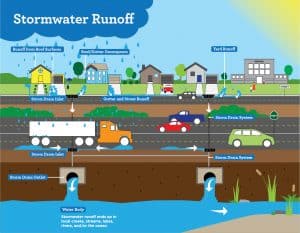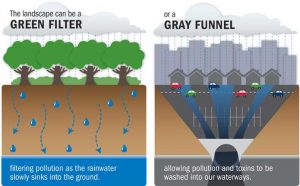[vc_row][vc_column]
 Stormwater is any runoff from precipitation like rain, snow, ice and sleet that collects on the landscapes and enters our streams and other water bodies. As stormwater flows across the landscape, it picks up many pollutants, including oil, grease, nutrients, sediment, and more that collect on the ground. While most stormwater then enters the storm sewer system, it still flows directly into our water bodies without being treated. This means that all of these potentially toxic pollutants collected as the stormwater moves are also entering our water bodies. These toxins can degrade water quality and adversely affect the organisms living in our water bodies. Some pollutants, like bacteria, excess nutrients, and fecal coliform, can even cause health risks to the surrounding community.[/vc_cta][/vc_column][/vc_row][vc_row][vc_column]
Stormwater is any runoff from precipitation like rain, snow, ice and sleet that collects on the landscapes and enters our streams and other water bodies. As stormwater flows across the landscape, it picks up many pollutants, including oil, grease, nutrients, sediment, and more that collect on the ground. While most stormwater then enters the storm sewer system, it still flows directly into our water bodies without being treated. This means that all of these potentially toxic pollutants collected as the stormwater moves are also entering our water bodies. These toxins can degrade water quality and adversely affect the organisms living in our water bodies. Some pollutants, like bacteria, excess nutrients, and fecal coliform, can even cause health risks to the surrounding community.[/vc_cta][/vc_column][/vc_row][vc_row][vc_column] Commercial properties generally receive high volumes of traffic, resulting in more residual oil from vehicles left on parking lots. In some cases, high volumes of customer traffic may also mean more waste and debris on commercial properties as well. With more development comes more impervious surfaces that generate even more stormwater, and often this stormwater will collect higher concentrations of pollutants as a result of urbanization. Impervious surfaces prevent water from infiltrating into the soil and groundwater table. When water infiltrates into the soil, many of these harmful pollutants are also filtered out, whereas when impervious surfaces direct stormwater into the storm sewer system, these pollutants are emptied into our water bodies. Commercial properties generally see more of these problems than residential properties due to higher amounts of impervious surfaces and greater vehicular traffic.
Commercial properties generally receive high volumes of traffic, resulting in more residual oil from vehicles left on parking lots. In some cases, high volumes of customer traffic may also mean more waste and debris on commercial properties as well. With more development comes more impervious surfaces that generate even more stormwater, and often this stormwater will collect higher concentrations of pollutants as a result of urbanization. Impervious surfaces prevent water from infiltrating into the soil and groundwater table. When water infiltrates into the soil, many of these harmful pollutants are also filtered out, whereas when impervious surfaces direct stormwater into the storm sewer system, these pollutants are emptied into our water bodies. Commercial properties generally see more of these problems than residential properties due to higher amounts of impervious surfaces and greater vehicular traffic.
Identifying stormwater concerns on your commercial property is easy. For example, assessing the amount of impervious surface on your property can allow you to determine how great of an effect your property has on stormwater quality. Can you reduce the amount of impervious surface by replacing it with permeable pavement or other green infrastructure solutions? Does the impervious surface on your property disproportionately degrade stormwater quality? Any ponding or flooding on your property may also represent a stormwater issue.[/vc_column_text][/vc_column][/vc_row][vc_row][vc_column]
